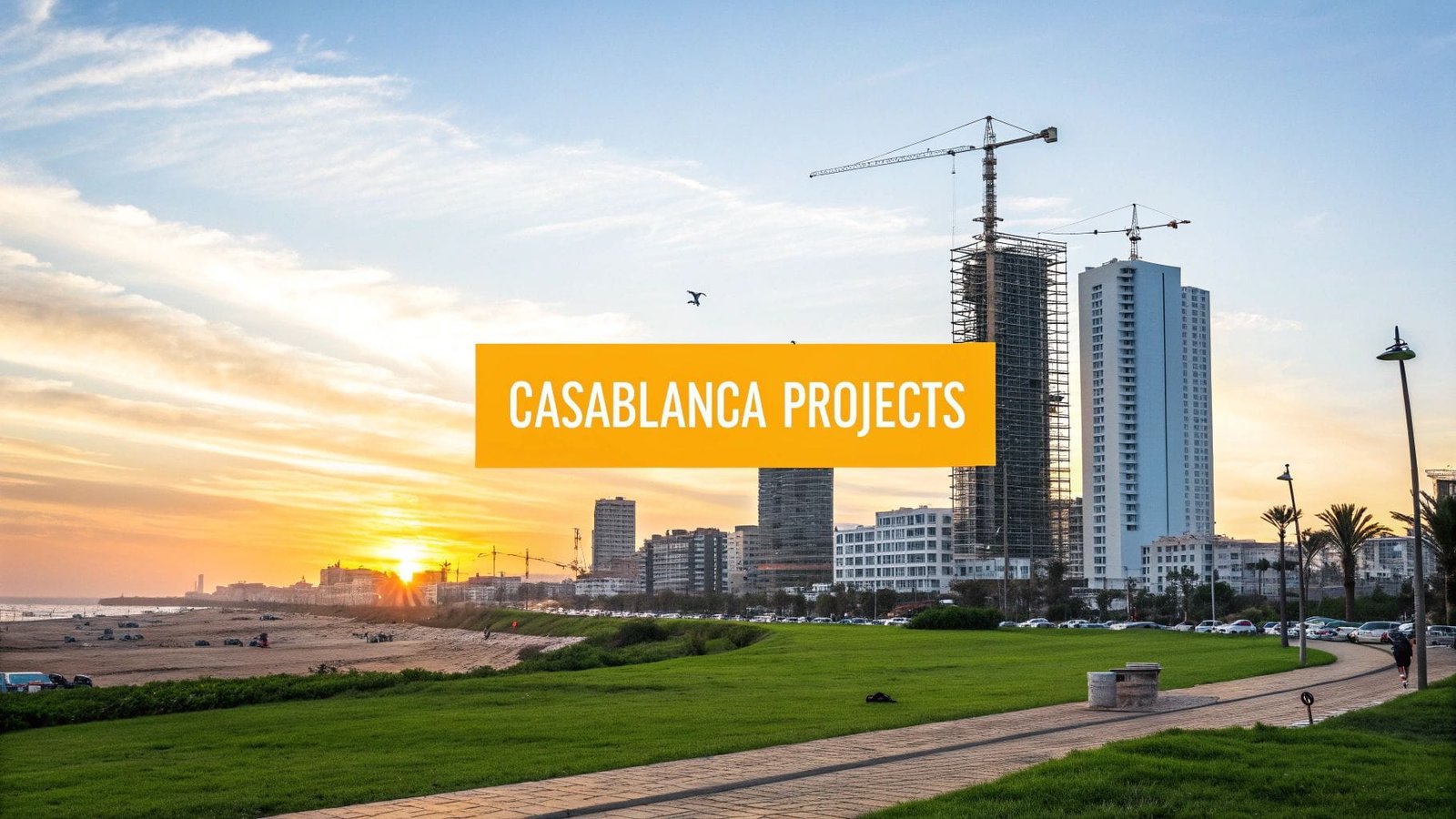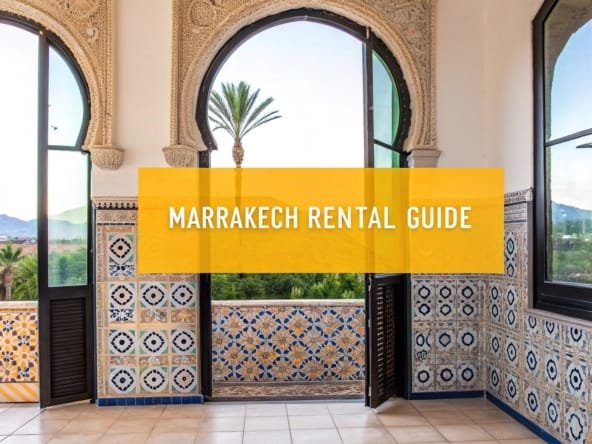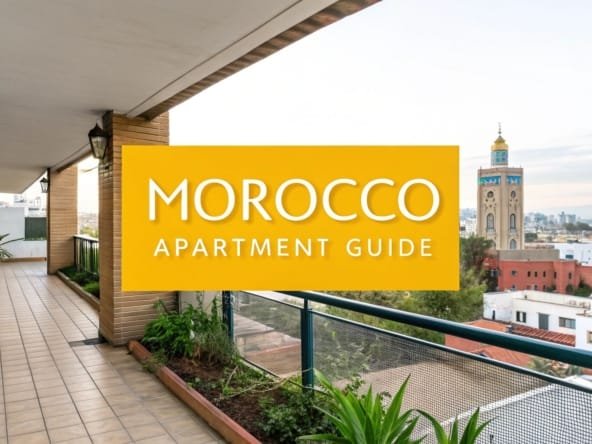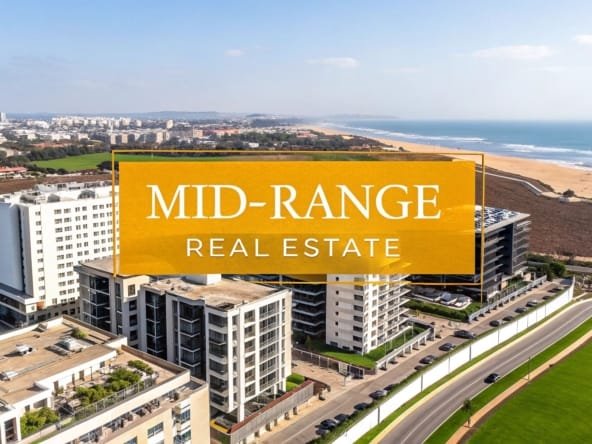Unlocking Casablanca's Real Estate Potential
Casablanca offers diverse real estate opportunities. This listicle outlines six key projet immobilier Casablanca strategies for 2025, helping you navigate this exciting market. Discover promising investment avenues, from emerging neighborhoods like Hay Hassani and Sidi Maarouf to luxury developments in Anfa and Racine. Whether you're interested in mixed-use projects, urban regeneration, social housing, or lucrative rental investments in business districts, this guide provides valuable insights for maximizing returns in Casablanca's dynamic property market.
1. Investissement dans les quartiers émergents (Hay Hassani, Sidi Maarouf)
For discerning investors seeking lucrative opportunities in the Casablanca real estate market, focusing on emerging neighborhoods like Hay Hassani and Sidi Maarouf presents a compelling strategy. This approach centers on identifying and investing in developing areas before they reach their full potential, capitalizing on the significant price appreciation that often accompanies urban growth. These districts typically benefit from ongoing infrastructure improvements and increasing demand, offering attractive returns for medium to long-term investments. This strategy is particularly relevant in a dynamic city like Casablanca, where urban development and expansion are constantly reshaping the real estate landscape. By strategically positioning themselves in these up-and-coming areas, investors can potentially reap substantial rewards as property values rise.
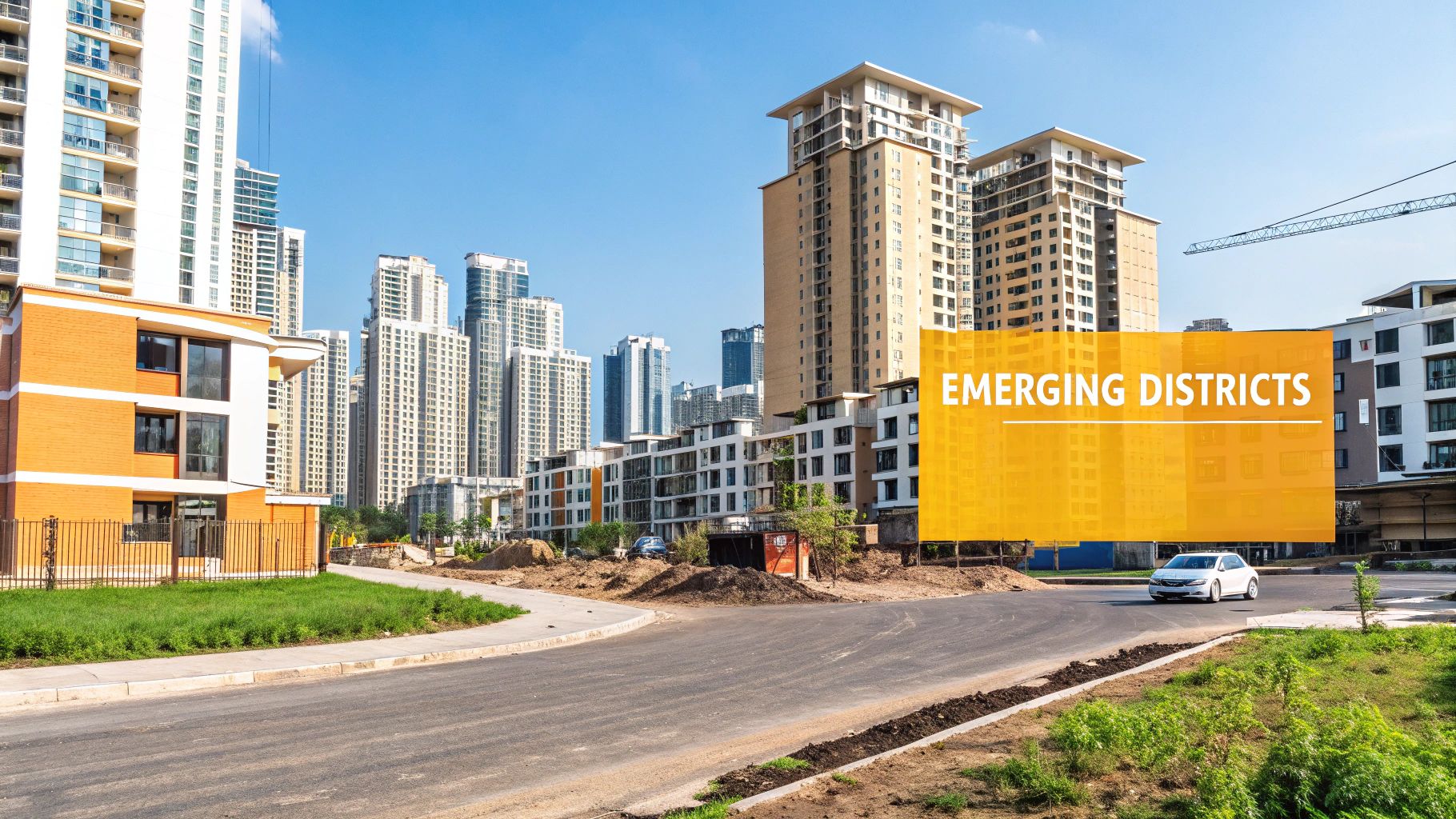
One of the primary attractions of investing in emerging neighborhoods is the significantly lower acquisition cost compared to established areas. This lower barrier to entry makes it an attractive option for a wider range of investors, including those with more moderate budgets. As these areas develop and infrastructure improves, property values tend to appreciate considerably, leading to a potentially high return on investment. Furthermore, these districts often experience a surge in demand for both residential and commercial properties, creating a vibrant rental market and further boosting investment potential. The ongoing development of modern infrastructure, including transportation networks, commercial centers, and public amenities, enhances the appeal and value of properties in these areas. For those interested in learning more, Learn more about Investissement dans les quartiers émergents (Hay Hassani, Sidi Maarouf).
Hay Hassani, for example, is undergoing a transformation into a modern residential hub, while Sidi Maarouf is experiencing rapid development centered around its burgeoning technopole. Nouaceur, another promising area, is witnessing growth driven by its proximity to the Mohammed V International Airport. These examples illustrate the potential for substantial returns in strategically chosen emerging neighborhoods.
However, like any investment strategy, investing in emerging areas carries certain risks. Development might progress slower than anticipated, and existing infrastructure might be initially inadequate. Short-term liquidity can be limited, and future urban planning changes can introduce uncertainty. Therefore, thorough due diligence is crucial.
To mitigate these risks, prospective investors should carefully study the city's urban development plans and analyze planned infrastructure projects. Visiting the neighborhoods at different times of day can provide valuable insights into their character and potential. Consulting local demographic statistics can also help gauge future demand. Understanding the long-term vision for these areas is key to making informed investment decisions.
The advantages of this approach include a potentially high return on investment, a more accessible financial entry point, the benefit of future urban improvements, and growing rental demand. However, potential drawbacks include the risk of slower-than-expected development, initially insufficient infrastructure, potentially reduced short-term liquidity, and uncertainty surrounding future urban planning.
This investment strategy is particularly well-suited for investors with a medium to long-term horizon and a higher risk tolerance. It is ideal for those seeking significant capital appreciation and who are comfortable navigating the complexities of developing markets. For those seeking to capitalize on Casablanca's dynamic growth, investing in carefully selected emerging neighborhoods offers a compelling pathway to potentially lucrative returns within the "projet immobilier Casablanca" landscape. By thoroughly researching the market, assessing potential risks, and adopting a long-term perspective, investors can position themselves for success in these promising areas.
2. Développement de projets mixtes (résidentiel-commercial)
In Casablanca's dynamic real estate market, mixed-use developments are emerging as a prominent trend, reshaping the urban landscape and offering exciting opportunities for both residents and investors. These projects, combining residential and commercial spaces within a single development, create integrated urban ecosystems that cater to the evolving needs of modern city living. This approach signifies a shift away from traditional, segregated urban planning towards a more holistic and interconnected model. By incorporating diverse elements like residential apartments, retail outlets, office spaces, entertainment venues, and even green areas, mixed-use projects aim to offer a convenient and vibrant lifestyle within a self-contained environment. This strategy directly addresses the increasing demand for practical urban living, where residents can live, work, shop, and socialize within close proximity, minimizing commutes and maximizing convenience. For developers, this model generates diversified revenue streams, reducing reliance on a single sector and enhancing the overall financial stability of the project.

Mixed-use developments offer a range of features designed to create a thriving community. These include the integration of residential units with various types of commercial spaces and essential services, creating a self-sufficient environment. The approach also optimizes land use, a critical factor in densely populated urban areas like Casablanca. By combining multiple functions within a single development, these projects minimize urban sprawl and maximize the utilization of available land. Furthermore, the creation of autonomous communities fosters a sense of belonging and encourages social interaction among residents. From a financial perspective, the diversification of revenue sources through rent from both residential and commercial spaces creates a more resilient and stable investment.
The advantages of mixed-use projects in a bustling metropolis like Casablanca are numerous. The diversification of income streams inherent in this model significantly reduces investment risk. Should one sector experience a downturn, the others can provide a buffer, ensuring a more stable return on investment. For residents, the convenience and accessibility of amenities within walking distance significantly enhance the project's attractiveness. This integrated approach also optimizes infrastructure costs, as shared facilities and services can be utilized more efficiently. Finally, the presence of various components within the development creates a synergistic effect, with each element contributing to the overall value and appeal of the project. Commercial spaces benefit from a readily available customer base within the residential component, while residents enjoy the convenience of having shops, restaurants, and other services right at their doorstep.
However, this approach is not without its challenges. Managing a mixed-use development is inherently more complex than managing a single-purpose project, requiring expertise across various sectors. The initial investment is also typically higher due to the multifaceted nature of the development. Navigating the more complex regulatory framework associated with mixed-use projects can also present a hurdle.
Successful examples of this model in Casablanca include Morocco Mall and its adjacent residences, Anfa Place, a prominent integrated project in the heart of the city, and Marina Shopping with its accompanying residential developments. These projects showcase the potential of mixed-use developments to revitalize urban areas and provide a desirable lifestyle.
For those considering investing in or developing a mixed-use project in Casablanca, several key tips can contribute to success. Thorough research into the complementary nature of the chosen activities is crucial, ensuring a synergistic relationship between the different components. Careful planning of traffic flow within the development is essential to avoid congestion and ensure smooth movement. Adequate parking provisions are also critical, considering the needs of both residents and visitors to commercial spaces. Finally, implementing a centralized and efficient management system is vital for the smooth operation of the entire development. Leading developers in this space, like Groupe Addoha, CGI (Compagnie Générale Immobilière), and Groupe Al Omrane, have demonstrated the potential of this approach within the "projet immobilier casablanca" landscape. Their projects serve as excellent examples of how mixed-use developments can contribute to the growth and modernization of the city.
3. Réhabilitation et rénovation du patrimoine urbain
Casablanca, a bustling metropolis with a rich history, offers a unique opportunity within its "projet immobilier" landscape: the rehabilitation and renovation of its urban heritage. This approach focuses on restoring and modernizing historic buildings and districts, breathing new life into the city's architectural gems while preserving its unique character. This strategy is particularly relevant in areas like the ancient medina and the Art Deco districts, where it aims to create real estate value while simultaneously safeguarding Casablanca's cultural legacy. This makes it an attractive option for investors seeking both financial returns and a connection to the city's past.
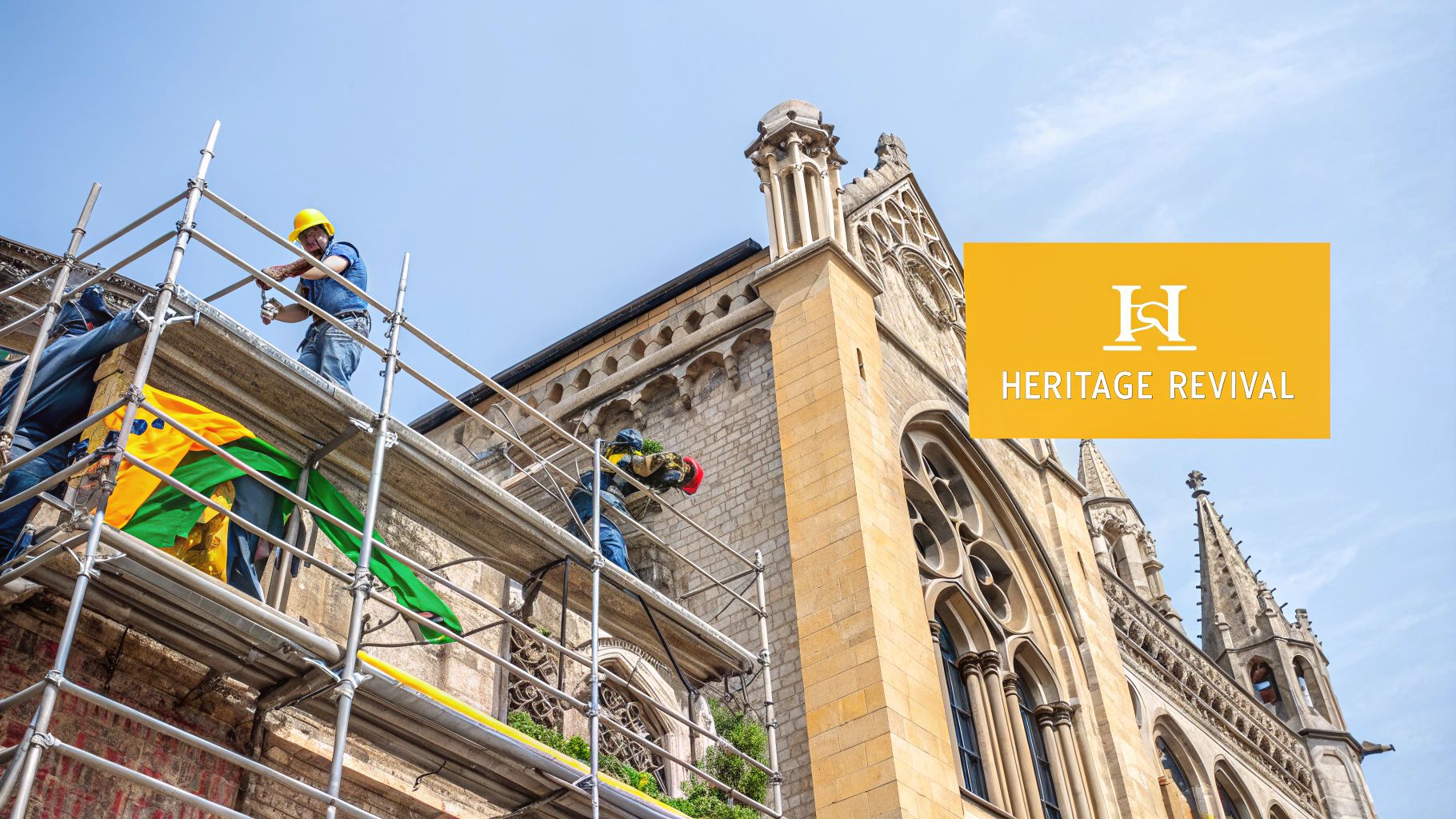
This revitalization process involves several key features, including the meticulous preservation of architectural heritage, the modernization of essential infrastructure, and the enhancement of cultural and touristic value. Crucially, all work is carried out with strict adherence to historical norms and regulations. This approach ensures that the restored buildings maintain their authenticity and contribute to the overall charm and historical integrity of Casablanca.
The rehabilitation of existing structures offers several advantages. Firstly, it contributes significantly to the valorization of cultural heritage, preserving a tangible link to Casablanca's past for future generations. Secondly, land costs in these historic districts are often advantageous compared to developing new projects in already saturated areas. Furthermore, public authorities often provide support and incentives for projects that contribute to the preservation of cultural heritage. Finally, these renovated properties can become significant tourist attractions, boosting the local economy and adding to the city's vibrant cultural scene.
Several successful examples demonstrate the potential of this approach. The renovation of traditional riads in the ancient medina has transformed these historic dwellings into sought-after properties, attracting both tourists and residents. Similarly, the restoration of Art Deco buildings in the city center has revitalized these architectural masterpieces, creating prime commercial and residential spaces. Larger-scale projects, such as the rehabilitation of the Habous district, showcase the transformative impact of this strategy on entire neighborhoods.
However, it’s important to be aware of the challenges involved. Strict regulatory constraints govern renovations in historic districts, requiring meticulous planning and adherence to specific guidelines. Renovation costs can sometimes be higher than new construction due to the specialized work and materials required. The technical complexity of restoring old buildings can also present challenges, often necessitating the involvement of specialized architects and craftsmen. Finally, project timelines can be longer due to the meticulous nature of the work and the need for approvals from various authorities.
For those considering investing in the rehabilitation of Casablanca's urban heritage, several tips are crucial. Consulting with the heritage services before embarking on any project is paramount to understanding the specific regulations and requirements. Engaging architects specializing in historical restoration is essential for ensuring the project's authenticity and structural integrity. It's crucial to prepare a substantial renovation budget that accounts for potential unforeseen costs. Finally, thoroughly researching available tax incentives and grants can significantly reduce the financial burden of these projects.
This approach to "projet immobilier casablanca" isn't just about bricks and mortar; it's about weaving together the past and the future. By choosing to invest in the rehabilitation and renovation of existing structures, developers and investors contribute to the preservation of Casablanca's unique identity while creating valuable and attractive properties in the heart of this dynamic city. This makes it a compelling option for those seeking a unique investment opportunity within the vibrant Casablanca real estate market.
4. Investissement dans l'immobilier haut de gamme (Anfa, Racine)
Casablanca, a bustling metropolis and the economic heart of Morocco, offers a diverse range of real estate investment opportunities. Among these, the high-end property market in prestigious districts like Anfa and Racine stands out as a particularly attractive option for discerning investors. This strategy targets the premium segment of the Casablanca property market, focusing on affluent local and international clients seeking exceptional properties with top-tier amenities and services. This investment approach, while requiring a substantial initial outlay, offers significant potential for high returns and long-term value appreciation. It represents a unique niche within the broader "projet immobilier Casablanca" landscape, catering to a specific clientele and offering a distinct set of advantages and challenges.
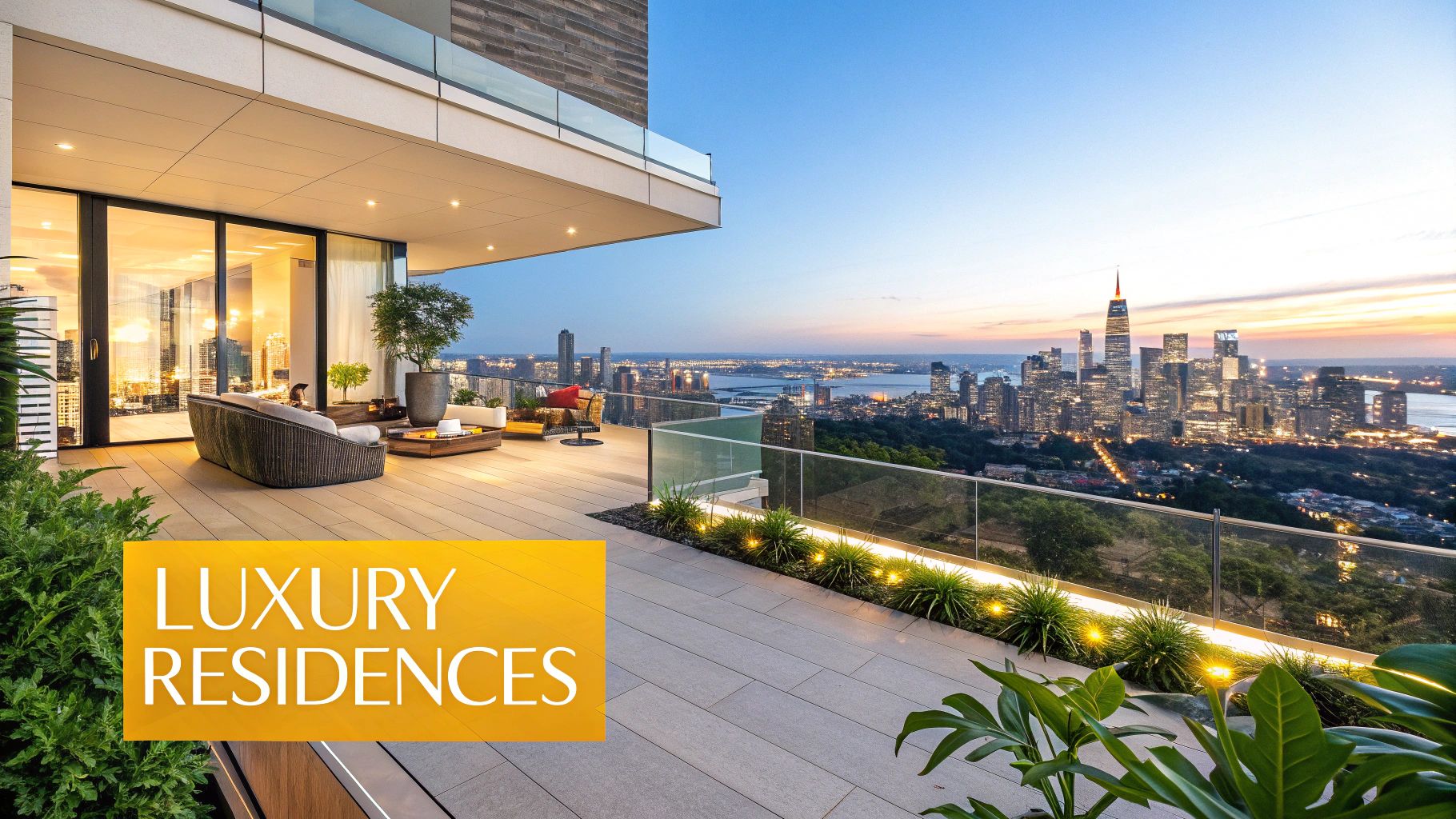
Investing in high-end real estate in Casablanca involves acquiring properties in prime locations, such as luxury residences in Anfa Supérieur, penthouses with breathtaking sea views in Ain Diab, or prestigious villas in Racine and California. These properties are characterized by their premium finishes, state-of-the-art equipment, and exclusive services, including concierge services and enhanced security measures. Often, these developments also incorporate lush green spaces and recreational facilities, adding to their allure and exclusivity. This approach caters to a clientele that prioritizes luxury, comfort, and convenience, and is willing to pay a premium for these features. Learn more about Investissement dans l'immobilier haut de gamme (Anfa, Racine)
Several factors contribute to the attractiveness of this investment strategy within the "projet immobilier Casablanca" context. Firstly, the high-end market offers higher profit margins compared to other segments. Secondly, the clientele is typically financially stable, ensuring consistent rental income and minimizing the risk of defaults. Thirdly, high-end properties tend to be more resilient to market fluctuations, offering a degree of stability in uncertain economic times. Finally, owning a prestigious property in a coveted location enhances one's image and brand, adding a layer of social capital to the investment.
Successful examples of this strategy can be seen in the projects developed by renowned developers like Palmeraie Développement, Groupe TGCC, and Alliances Développement Immobilier. These companies have consistently delivered high-quality, luxury projects that have set new standards for upscale living in Casablanca. Their success underscores the viability and profitability of investing in the high-end segment of the Casablanca property market.
However, it's crucial to acknowledge the potential downsides. This is a niche market with limited demand, meaning that finding buyers or renters can take longer. The initial investment required is substantial, often requiring significant capital outlay or access to financing. Furthermore, the high-end market can be sensitive to economic downturns, although generally less so than other segments. Finally, maintaining the required high standards of quality and service can be demanding and costly.
For those considering this investment approach, several tips can help maximize success. Thorough research is essential to understand the specific demands of the high-end market. Prioritizing prime locations with desirable views is paramount. Investing in exceptional finishes and amenities is crucial to attracting discerning clients. Finally, developing partnerships with luxury brands can enhance the prestige and appeal of the property.
This investment strategy is particularly suited for investors with a high-risk tolerance and a long-term investment horizon. It's ideal for those seeking high returns, stable income streams, and a prestigious asset that holds its value over time. While it presents certain challenges, the potential rewards and the unique position within the "projet immobilier Casablanca" market make it a compelling option for sophisticated investors.
5. Développement de logements sociaux et économiques
Casablanca's rapid urbanization and growing population have created a significant demand for affordable housing, making "Développement de logements sociaux et économiques" (Development of social and economic housing) a crucial aspect of the projet immobilier Casablanca landscape. This approach focuses on constructing affordable housing units to meet the needs of the middle and working classes, a segment often underserved by the traditional real estate market. This focus not only addresses a pressing social need but also presents a significant market opportunity within the larger projet immobilier Casablanca context.
This segment of the market operates differently from luxury developments or high-end apartments. It prioritizes volume and affordability, often leveraging government support and subsidies to make housing accessible to a wider population. This makes it a particularly attractive area for investors seeking stable, long-term returns in the projet immobilier Casablanca scene, and a vital consideration for individuals and families seeking affordable housing options.
How it Works:
The development of social and economic housing in Casablanca typically involves a combination of public and private initiatives. The government plays a key role by providing land, subsidies, and tax incentives to encourage private developers to participate. This often takes the form of public-private partnerships, allowing for the efficient allocation of resources and expertise. Developers, in turn, focus on optimizing construction costs and streamlining processes to deliver affordable units while maintaining acceptable quality standards. This careful balance is crucial for the successful execution of any projet immobilier Casablanca focused on social housing.
Examples of Successful Implementation:
Several programs have demonstrated the viability of social and economic housing within the projet immobilier Casablanca market:
- Programmes Villes Sans Bidonvilles: This initiative aims to eradicate shantytowns and provide decent housing for residents, contributing significantly to the overall improvement of urban living conditions. This aligns directly with the social responsibility component of projet immobilier Casablanca.
- Projets Addoha dans la périphérie: Addoha Group, a major player in the Moroccan real estate market, has undertaken large-scale projects in Casablanca's suburbs, providing affordable housing options for a large segment of the population. These projects highlight the scale and impact possible within projet immobilier Casablanca focused on social housing.
- Programmes Al Omrane en partenariat public-privé: Al Omrane, a public agency specializing in housing development, has successfully implemented numerous projects through public-private partnerships, demonstrating the effectiveness of this collaborative approach within the projet immobilier Casablanca framework.
Actionable Tips for Investors and Developers:
For those looking to engage with this segment of projet immobilier Casablanca:
- Optimize construction costs: Employing efficient building techniques, utilizing cost-effective materials, and streamlining processes are crucial for maximizing profitability while maintaining affordability.
- Privilégier les partenariats avec l'État: Leveraging government support through subsidies, tax incentives, and land allocation can significantly reduce project costs and enhance feasibility within the projet immobilier Casablanca context.
- Standardize production processes: Implementing standardized designs and construction methods can lead to economies of scale and increased efficiency.
- Cibler les zones de relogement prioritaires: Focusing on areas designated for resettlement and redevelopment offers access to government support and addresses a pressing social need within projet immobilier Casablanca.
Pros and Cons:
- Pros: High demand driven by a large target market, government support and incentives, positive social impact, quick inventory turnover.
- Cons: Reduced profit margins, strict price constraints, basic construction standards, dependence on government policies.
When and Why to Use This Approach:
This approach is ideal for developers and investors seeking long-term, stable returns within the projet immobilier Casablanca market, particularly those with a focus on social responsibility. It caters to a massive and consistently growing market segment, providing a reliable source of demand. However, it's essential to be prepared for lower profit margins compared to high-end developments. Understanding the unique challenges and opportunities presented by social and economic housing is crucial for success within the projet immobilier Casablanca landscape. This segment contributes significantly to addressing housing shortages and fostering inclusive urban development, making it a vital consideration for any stakeholder involved in projet immobilier Casablanca.
6. Investissement locatif dans les zones d'affaires
Casablanca, the economic heart of Morocco, presents a dynamic landscape for real estate investment. Within this vibrant market, "investissement locatif dans les zones d'affaires," or rental investment in business districts, stands out as a compelling strategy for achieving consistent returns and long-term capital growth within a "projet immobilier Casablanca." This approach focuses on acquiring or developing properties specifically for lease within Casablanca's primary economic hubs, capitalizing on the constant demand for office spaces, retail locations, and industrial facilities. This makes it a particularly attractive option for those seeking a stable income stream and a strong foothold in the Moroccan property market.
This investment strategy hinges on understanding the specific dynamics of Casablanca's commercial real estate sector. It requires careful consideration of location, property type, and lease terms to maximize profitability and mitigate risks. By targeting key business areas, investors position themselves to benefit from consistent rental income driven by the ongoing need for commercial spaces. The stability and growth potential of this approach solidify its place as a key consideration for any serious "projet immobilier Casablanca."
Several factors contribute to the appeal of this investment model. The diversity of property types available, including offices, retail spaces, and warehouses, allows investors to diversify their portfolios and cater to different market segments. For example, the burgeoning tech sector might drive demand for modern office spaces, while the growing consumer market fuels the need for retail outlets. This flexibility enables investors to tailor their "projet immobilier Casablanca" to their specific risk appetite and investment goals.
Furthermore, long-term commercial leases provide predictable cash flow and minimize vacancy periods. These leases often include clauses for rent adjustments linked to inflation, protecting investors against erosion of purchasing power. Learn more about Investissement locatif dans les zones d'affaires for a deeper understanding of the Casablanca office market dynamics.
Several prime examples illustrate the successful implementation of this strategy. The modern office towers springing up in Casa-Anfa cater to multinational corporations and financial institutions. The thriving commercial spaces in Sidi Maarouf attract a diverse range of businesses, from retail giants to local entrepreneurs. Likewise, the industrial zones, such as the one near the port, offer warehousing and logistics solutions to businesses engaged in import and export activities. These successful "projet immobilier Casablanca" developments underscore the potential for significant returns in the city's bustling commercial real estate sector.
However, like any investment, "investissement locatif dans les zones d'affaires" carries inherent risks. Economic downturns can impact occupancy rates and rental income. Periods of vacancy, while potentially minimized by long-term leases, can still occur and impact cash flow. Ongoing maintenance and management costs also need to be factored into the investment equation. Finally, the initial investment outlay can be substantial, potentially requiring significant capital or financing.
To navigate these challenges and maximize the chances of success, investors should consider the following actionable tips:
- Analyze the rental demand by sector: Understanding which industries are thriving in Casablanca and their specific space requirements is crucial for choosing the right property type and location.
- Prioritize accessible locations: Properties with good transport links and proximity to amenities are more attractive to tenants, leading to higher occupancy rates.
- Negotiate secure leases: Well-structured lease agreements with clear terms and conditions are essential for protecting your investment and ensuring a steady income stream.
- Plan for professional property management: Engaging a professional property management company can streamline operations, handle tenant relations, and ensure efficient maintenance, maximizing the return on your investment.
"Investissement locatif dans les zones d'affaires" offers a compelling pathway for investors seeking stable returns and long-term capital appreciation within a "projet immobilier Casablanca." By carefully analyzing market trends, mitigating risks, and implementing a strategic approach, investors can capitalize on Casablanca’s vibrant economic landscape and secure a profitable future in the Moroccan real estate market. This strategy is particularly appealing for investors looking for consistent income generation, portfolio diversification within the Moroccan real estate sector, and the potential for long-term capital appreciation within a thriving urban environment.
Comparative Analysis of 6 Casablanca Real Estate Strategies
| Strategy Title | Implementation Complexity 🔄 | Resource Requirements ⚡ | Expected Outcomes 📊 | Ideal Use Cases 💡 | Key Advantages ⭐ |
|---|---|---|---|---|---|
| Investment in Emerging Districts (Hay Hassani, Sidi Maarouf) | Medium 🔄🔄 | Moderate ⚡⚡ | High potential appreciation over medium to long term 📊📊 | Investors seeking affordable entry with growth potential 💡 | Affordable acquisition, urban development benefits, growing rental demand ⭐⭐ |
| Mixed-Use Project Development (Residential-Commercial) | High 🔄🔄🔄 | High ⚡⚡⚡ | Diversified income streams and integrated communities 📊📊📊 | Developers targeting urban lifestyle demand and risk diversification 💡 | Revenue diversification, infrastructure cost optimization, enhanced attractiveness ⭐⭐⭐ |
| Heritage Rehabilitation and Renovation | High 🔄🔄🔄 | High ⚡⚡ | Cultural value preservation and tourism boost 📊📊 | Projects focused on historic districts with cultural impact 💡 | Cultural value, government support, attractive land costs ⭐⭐ |
| Investment in High-End Real Estate (Anfa, Racine) | Medium-High 🔄🔄🔄 | Very High ⚡⚡⚡ | High profit margins and market resilience 📊📊 | Targeting affluent local/international buyers seeking luxury housing 💡 | High margins, wealthy clientele, strong brand image ⭐⭐⭐ |
| Social and Economic Housing Development | Medium 🔄🔄 | Moderate ⚡⚡ | Large volume sales with positive social impact 📊 | Affordable housing for middle/lower-income populations with govt support 💡 | Large market demand, government incentives, fast stock turnover ⭐⭐ |
| Rental Investment in Business Districts | Medium 🔄🔄 | High ⚡⚡ | Stable rental income and capital appreciation 📊📊 | Investors focusing on commercial real estate in economic hubs 💡 | Regular income, inflation-indexed leases, strong tenant demand ⭐⭐ |
Making Informed Decisions with Rich Lion Properties
Navigating the dynamic projet immobilier Casablanca landscape can be complex, encompassing everything from emerging neighborhoods like Hay Hassani and Sidi Maarouf to high-end properties in Anfa and Racine. This article has highlighted key trends shaping the market, including mixed-use developments, urban regeneration projects, social housing initiatives, and lucrative investment opportunities in bustling business districts. Understanding these diverse facets is crucial for making sound investment decisions, whether you're a first-time buyer, a seasoned investor, or a business seeking commercial space. Mastering these concepts empowers you to capitalize on Casablanca's burgeoning real estate market and secure long-term financial success.
By recognizing the nuances of each projet immobilier Casablanca sector – from luxury apartments to affordable housing and commercial spaces – you can strategically position yourself for maximum returns. Whether your goal is capital appreciation, rental income, or finding the perfect home, informed decisions are the cornerstone of achieving your real estate objectives.
Ready to unlock the full potential of projet immobilier Casablanca? Rich Lion Properties specializes in navigating the complexities of the Casablanca real estate market, offering expert guidance and tailored solutions for every client. Visit Rich Lion Properties today to discover how our comprehensive services can help you achieve your real estate goals in Casablanca.
